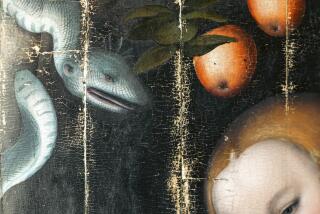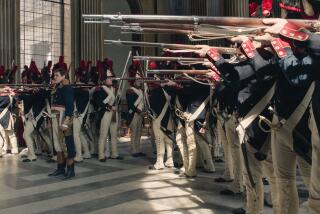Getty Assists in Analysis of First Photograph
Propped up in a darkened room and illuminated at an oblique angle, the flat rectangle of pewter reluctantly reveals the scene it has faithfully held for 176 years.
“You have to dance around it to get a good view,” Dusan Stulik, a senior scientist at the Getty Conservation Institute, said as he hovered nearby.
You do, and the plate flashes gold before going dark. A step forward, one back and somewhere in between an image emerges. A farm building. Pear and poplar trees. A dovecote.
Together, the objects appear just as they did to Joseph Nicephore Niepce in 1826, when the Frenchman created what is acknowledged as the world’s first photograph.
“All of the history of photography, the history of film, the history of television: If you go back, this is where all those histories unite,” Stulik said of the faint image.
Since the photograph arrived on June 14 at the Getty, experts have begun the first scientific study of the image since it was rediscovered and authenticated in 1952.
“This is the first time we have done any analysis. This is an opportunity to really see it for the first time since it was done,” said Roy Flukinger, a senior curator at the Harry Ransom Humanities Research Center at the University of Texas at Austin, which acquired the image in 1963.
The analysis is part of a joint photo conservation project with the Getty, the Image Permanence Institute at the Rochester Institute of Technology and France’s Centre de Recherches sur la Conservation des Documents Graphiques.
Over the last week, scientists have pored over the 8-inch-by-6 1/2-inch photograph with advanced scientific instruments and assessed its state of preservation, which is generally good.
Experts will repair its original frame and build a new airtight case for it. They have also photographed the image, which is difficult given its faintness.
Previous reproductions were little more than retouched mosaics of various images made in the 1950s.
Study results are preliminary but confirm accounts that Niepce used a polished plate of pewter, just one-sixteenth-of-an-inch thick, coated with a thin layer of bitumen to create the image.
During an exposure made over as many as three days, the light-sensitive petroleum derivative hardened. Washing the plate with a mixture of oil of lavender and white petroleum dissolved the unexposed portions of bitumen.
Niepce called the permanently fixed, direct positive picture--the first ever captured from nature--a “heliograph.”
The original image returns to Austin on Monday.


